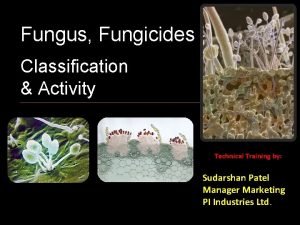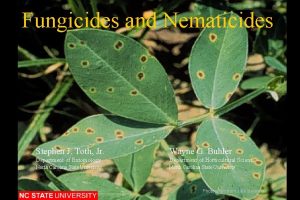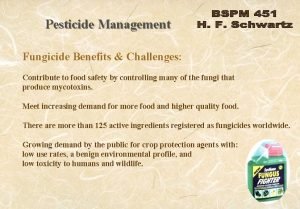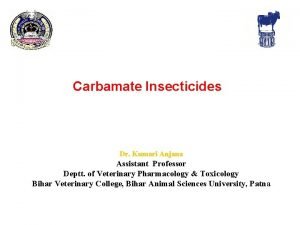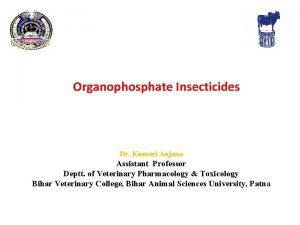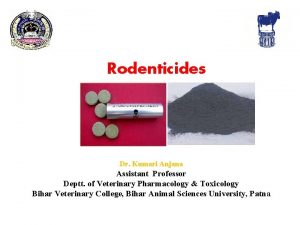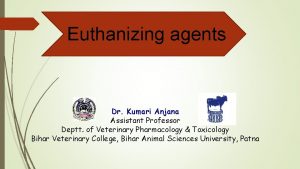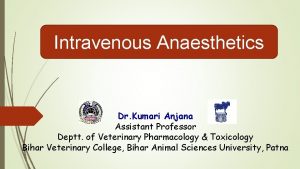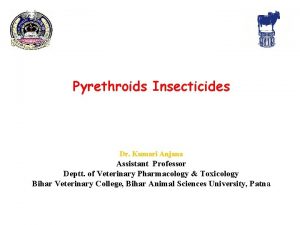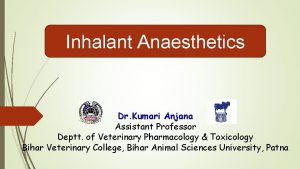Fungicides Fumigants Dr Kumari Anjana Assistant Professor Deptt










- Slides: 10

Fungicides & Fumigants Dr. Kumari Anjana Assistant Professor Deptt. of Veterinary Pharmacology & Toxicology Bihar Veterinary College, Bihar Animal Sciences University, Patna

Content of the chapter • • • Introduction Classification Mechanism of action Clinical signs Diagnosis Treatment

Fungicides These are agrochemicals used to prevent or control fungal infestation of grains, seeds, fruits, vegetables, orchard plants or field crops. Fungicides are classified as; inorganic and organic fungicides.

Inorganic Fungicides Sulphur: • Its toxicity is due to its oxidation compounds (sulphur dioxide, sulphur trioxide and thiosulfuric acid) or formation of hydrogen sulphide. • Its toxicity is also due to its cross linking of proteins or through formation of free radicals. • Sulphur is toxic to cattle, horse and poultry. • The signs of toxicity include colic, gastroenteritis and diarrhoea. Treatment of toxicity is symptomatic. Bordeaux mixture (copper sulphate + calcium hydroxide). Cadmium chloride:

Organic fungicides • Organomercury compounds: Phenylmercury chloride and phenylmercury acetate • Chlorophenols: Pentachlorophenol (PCP): it is fungicide, molluscicide, insecticide, herbicide and wood preservative. Their toxicity is due to uncoupling of oxidative phosphorylation. • Dithiocarbamates: Ziram, febam, zineb, maneb, thiram etc: Cause GI disturbances and nervous toxicity. • Phthalimides: Captan, flopet and captofol: More toxic to ruminants than other animals; cause dyspnoea, ascites, hydrothorax and gastroenteritis.

Fumigants • These are used as grain protectants against insets in the form of fumigation (gaseous) and also to kill the rodents (as baits like rodenticides). • The fumigants are either easily volatile liquids or solids capable of liberating gases. • Fumigants are used in closed rooms or chambers or containers. • These as insecticides, being in gaseous form, are also effective against insects in the burrows (like bed bugs) not usually accessible to conventional pesticides.

Inorganic Fumigants Aluminium phosphide: • Exerts action though liberation of phosphine gas like zinc phosphide; causes respiratory tract irritation in animals. • Hydrogen cyanide (HCN): Toxicity due to cyanide. Carbon disulfide (CS 2): • Interferes with axon function by forming cross linking between neurofilaments. • Its inhalation causes pulmonary oedema, respiratory distress, convulsions, coma and death. Sulphur dioxide (SO 2): • It causes respiratory toxicity.

Organic Fumigants Chloropicrin: • It has very strong chlorine smell. • Its inhalation causes coughing and respiratory distress. • Irritant to eyes and also causing nausea and vomition. Methyl bromide: • Insecticidal fumigant also used in fire extinguishers. • It causes neurotoxicity by inactivating –SH enzymes; • Its inhalation causes respiratory distress.

Ethylene dibromide: • A soil fumigant; • used to control soil worms. • Inhalation causes pulmonary distress. Dibromochloropropane (DBCP): • It is a nematocidal fungicide fumigant. • Its inhalation caused CNS depression and pulmonary oedema, and sterility in man (occupational exposure) as evident from low sperm counts.

Thank You




